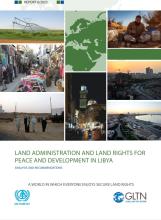Land Library
Bem-vindo à Biblioteca do Land Portal. Explore nossa vasta coleção de recursos de acesso aberto (mais de 74.000), incluindo relatórios, artigos de revistas científicas, trabalhos de pesquisa, publicações revisadas por pares, documentos jurídicos, vídeos e muito mais.
/ library resources
Showing items 1 through 9 of 2040.This report is a contribution towards the improvement of land management and land administration in Libya.
To ensure a better and more sustainable future for all, the 2030 Agenda for Sustainable Development (“the 2030 Agenda”) has identified 17 Sustainable Development Goals (SDGs) to be achieved by 2030.
The Global Land Indicators Initiative (GLII) platform was established in 2012 through the joint effort of United Nations Human Settlements Programme (UN-Habitat), the World Bank and Millennium Challenge Corporation with the aim of making global-scale monitoring of land governance a reality by 202
As a result of high-density urbanization and climate change, both the frequency and intensity of extreme urban rainfall are increasing.
Countries in Southeast Asia have been developing quickly from a predominantly rural to predominantly urban society, leading to a rapid increase in urban land. This increase in urban land has mainly occurred in river deltas and floodplains, exposing humans and human assets to flood hazard.
Soil thickness (ST) plays an important role in regulating soil processes, vegetation growth and land suitability. Therefore, it has been listed as one of twelve basic soil properties to be delivered in GlobalSoilMap project.
Ecosystem Services (ESs) are bundles of natural processes and functions that are essential for human well-being, subsistence, and livelihoods. The ‘Green Revolution’ (GR) has substantial impact on the agricultural landscape and ESs in India.
As the impact of climate change on the agricultural sector has begun to manifest itself in its severity, adaptation planning has come under scrutiny for favoring the preservation of status-quo conditions over more substantial changes.
Inclusionary housing (IH) is a regulatory instrument adopted by local governments in many countries to produce affordable housing by capturing resources created through the marketplace. In order to assess whether it is efficient, scholarly attention has been widely focused on its evaluation.



